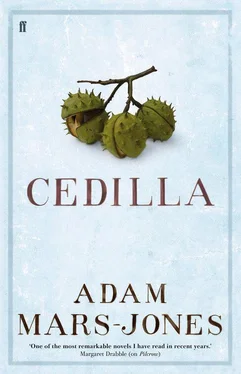Now that I was indoors I could tell that the household wasn’t absorbing the fact of my presence quite as smoothly as it seemed. The establishment had been set on its ears, in the nicest possible way, by the arrival of this visitor — this person who had come from England all on his own but couldn’t cross a room, let alone continue his pilgrimage, without help. I was an astonishment and a wonder.
Next to make herself known was Raghu’s daughter Chu-cha, who must have been about ten at the time. I used the technique I’ve evolved over time for the reassurance of children, whose curiosity is so highly developed, whose vulnerability to embarrassment follows it every step of the way. I gave a little nod at the opposite wall and said, ‘Is that you in that picture?’ In fact I could hardly see the photograph I was indicating, and had no evidence that the girl even spoke English.
The point was to convey that I would be fixing my attention safely on the middle distance for as long as she pleased to look at me. I was giving a sort of permission, by saying in effect, ‘ I’m going to be looking in this direction for a while — where you look is your business.’ I wouldn’t embarrass her by intercepting her gaze prematurely, and our eyes would meet only when she had adjusted to what was unfamiliar about me. It was up to me to create a sort of antechamber to this first encounter, where a stranger could compose herself.
When this had all been managed I asked Chu-cha, ‘Is your mother in?’ and she looked rather doubtfully at her father. He explained that she was indeed in the house — where else would she be? — but it was polite, when a visitor came, for a wife to wait for twenty minutes or so until called to present herself. When the time came he called softly and Sumati appeared, bowing in the sinuous posture of Namaskaaram, which alas I had no prospect of returning properly. She had to take the thought for the deed like everyone else. Her hair had a wonderful oiled shine to it, and the fragrance she carried made English scents seem two-dimensional.
Delicate balance of hospitality
She offered refreshment before retiring gracefully to attend to her duties. This too was the proper procedure. Would I care for some sweet-lime juice? I would. I was determined to drink it slowly when it came, delicious though it was, so as to defer as long as possible the moment when I needed the lavatory and tipped the delicate balance of hospitality into something cruder and more compromised. There is such a marked social difference between intake and output in digestive matters. It was too much to hope that Tamil Nadu would be the culture that disproved that rule, with excretion and embarrassment showing no overlap.
Chu-cha settled herself on a mat near my feet so that she could examine me closely — evidence that any nervousness had been dispelled. She felt entitled to look as much as she wanted.
Sumati must have been busy in the kitchen, and before long we were summoned to the large dining table. I was offered eating implements from a little revolving canteen of knives, forks and spoons, hung up by holes in their handles. My hosts would be eating by hand, but I was a Western Guest and would be lost without cutlery (true enough in my case). In the middle of the table was a large carousel loaded with cooked food, each dish in its own compartment.
I was slightly disappointed by the look of the room, since I expected the exotic in every detail. Here there were traces of the Habitat chic of the period. Low over the dining table hung a fat purple lamp-shade suspended from a pulley. The Washbournes had something very like it.
Raghu took great care to explain the system to me, though I wasn’t expected to use it. Sumati would serve me herself. Raghu gave the carousel a proud push, so that it rotated merrily for quite a time, diffusing the aromas of a dozen separate dishes in a centrifugal spiral. Raghu and the others had large stainless steel platters onto which they helped themselves with food from the carousel. The serving spoons in their compartments were the only utensils on the table, apart from the ones I was to use.
I was thoroughly entertained by the carousel system. It was fun to watch the wheel being given a push so that the dish in front of me was replaced by a new one. It made me want to try everything. As Sumati served me she would announce the name of the dish, and I repeated it as best I could, to show that I was more than a tourist getting his mouth burnt. I was having my first lesson in Tamil, as well as my first lesson in a cuisine of great depth and variety, not founded on animal sacrifice. So many morsels in savoury counterpoint. A banquet composed of a wide range of mini-meals — perfectly calculated to tantalise then satisfy this body’s appetite. The rice wasn’t offered on the carousel but came passed round from hand to hand in its own dish.
Raghu gave me a demonstration of Indian eating technique. You put small amounts of most things around the edge of the platter, leaving the centre area for the rice, of which you took a modest amount. Then you would mix with your right hand various dishes with a bit of rice in the centre, adding sambhar until the consistency felt right. I was reminded of a painter working with his palette, mixing pigments with white and each other until tone and tint were exactly what was needed to balance the composition.
The next trick was to mould the mix into little balls which you would pop into your mouth. To start with I found this a little bit horrifying, though I repeated to myself that nervous-genteel English mantra ‘Fingers were made before forks …’
Even so, it was with fascination and a slight revulsion that I watched Raghu eat his meal. I didn’t dare to start on mine. His fingers flashed with lightning speed, his hands whipped and swirled around the plate, and sometimes he would gather his dollop of food in the centre and then pound his hand up and down to squash everything together. It was a primitive and off-putting rigmarole. Yet during the process my attitude to what I was seeing changed completely, thanks to Raghu’s grace, charm and pride in hospitality. If I started watching his performance with a feeling of disgust masked by good manners, then by the time he had finished I was fully convinced that the food must taste very good. I found I was distinctly hungry myself.
Nothing filthier in the whole world
I set to work on my own behalf, rather self-consciously, using the Western utensils, wishing I made a better ambassador for British eating habits. From one compartment came sambhar , a spicy lentil soup. There were batatas , spicy chilli potatoes, and koftas , vegetarian dumplings in gravy. There was usli made with bread, chilli threads and cracked mustard seeds, there was kattirikkaay poriyal and sundal . The word I had most trouble with was appaLam , used to describe the crisp and crinkled discs, flavoured with seeds and spices, which made such a festive crackle between people’s fingers and teeth.
The L -sound in the word was deceptive and complex, more like the notorious Welsh double- l , that daunting, darkly bubbling sound, than anything in English articulation. I wouldn’t let myself try the food until my pronunciation had passed muster. There were a few false starts. Again, the business of getting my tongue round the words before it encountered the named food was palate-enlivening in some profound way. It was as if I had never tasted food before. A number of discrete areas of the brain were flashing at the same time, as on a pinball table with a wizard guiding the flippers. Palate-sensation and language learning shook hands, even did a little jig together.
When I was a bed-bound child Mum had given me her own kind of instruction in table manners, showing me that the ideal forkful represented every element that was present on the plate. This principle had its source in her social nervousness, which made her long for strict rules, but the idea appealed to the cadet scientist in me. Being identical, every forkful was an equally valid sample. My mouth was a laboratory whose experiments would yield verifiable and statistically suggestive results.
Читать дальше












